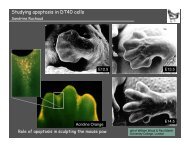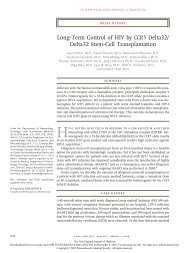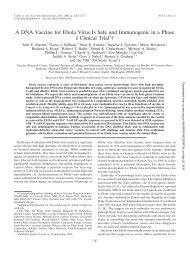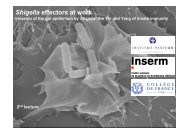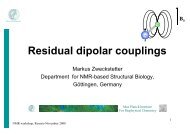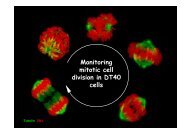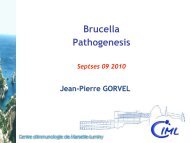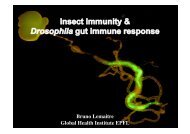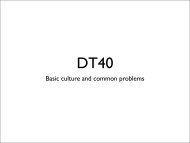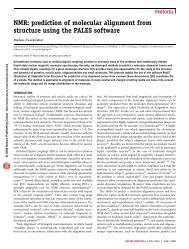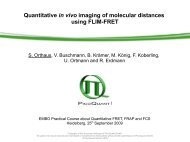pdf file - Events - EMBO
pdf file - Events - EMBO
pdf file - Events - EMBO
You also want an ePaper? Increase the reach of your titles
YUMPU automatically turns print PDFs into web optimized ePapers that Google loves.
<strong>EMBO</strong> Plant DNA Repair and Recombination Workshop, Presqu'île de Giens, France 2007<br />
(LNs). In tomato (Solanum lycopersicum), a cytological recombination map has been<br />
constructed based on LN positions. We demonstrate that the mismatch repair protein<br />
MLH1 occurs in LNs. We determined the positions of MLH1 foci along the 12 tomato<br />
bivalents during meiotic prophase and compared the map of MLH1 focus positions with<br />
that of LN positions. On all 12 bivalents, the number of MLH1 foci was app. 70% of the<br />
number of LNs. Bivalents with zero MLH1 foci were rare, which argues against random<br />
failure of detecting MLH1 in the LNs. We inferred that there are two types of LNs, MLH1positive<br />
and MLH1-negative LNs, and that each bivalent gets an obligate MLH1-positive<br />
LN. The two LN types are differently distributed along the bivalents. Furthermore,<br />
cytological interference among MLH1 foci was much stronger than interference among<br />
LNs, implying that MLH1 marks the positions of a subset of strongly interfering<br />
crossovers. Based on the distances between MLH1 foci or LNs, we propose that MLH1positive<br />
and MLH1-negative LNs stem from the same population of weakly interfering<br />
precursors.<br />
----------------------------------------------------------------------------------------------------------------------------------<br />
T - 32. Identification of meiotic DSB forming proteins in Arabidopsis thaliana<br />
Arnaud De Muyt, Lucie Pereira, Daniel Vezon, Ghislaine Gendrot, Mathilde Grelon Genetic<br />
and Plant Breeding, INRA, 78026 Cedex Versailles, France<br />
In budding yeast, meiotic recombination events are initiated by double strand breaks<br />
(DSBs) catalysed by the Spo11 protein. In this species, DSB formation also requires nine<br />
other proteins whose molecular function is poorly understood. Nevertheless, recent<br />
studies tend to group them into subcomplexes, indicating that they can be intimately<br />
linked and can form a large recombination initiation complex in which DSBs are made.<br />
Many investigations have been carried out to identify in other organisms, homologs of<br />
these DSB forming proteins. Unfortunately, unlike Spo11, most of these are not conserved<br />
across kingdoms. Furthermore, even when DSB proteins are conserved, their role in<br />
meiotic DSB formation is missing. A large-scale forward genetic approach to isolate plant<br />
meiotic genes has revealed the existence of new meiotic functions that could be<br />
necessary for meiotic DSB formation. We will present data concerning the isolation of one<br />
of these genes : AtPRD1 for Arabidopsis thaliana Putative Recombination initiation Defect<br />
1. In Atprd1 mutants, meiotic recombination rates fall dramatically, early recombination<br />
markers (e.g. DMC1 foci) are absent, but meiosis progresses until achiasmatic univalents<br />
are formed. Besides, Atprd1 mutants suppress DSB repair defects of a large range of<br />
meiotic mutants, showing that AtPRD1 is involved in meiotic recombination and is<br />
required for meiotic DSB formation. Furthermore, we showed that AtPRD1 and AtSPO11-1<br />
interact in a yeast two hybrid assay, suggesting that AtPRD1 is a partner of AtSPO11-1.<br />
----------------------------------------------------------------------------------------------------------------------------------<br />
T - 33. Recombination and genetic maps in Petunia<br />
tom gerats IWWR/Plant Genetics, Radboud University, 6525ED Nijmegen, Netherlands<br />
Most Petunia species have 2n=14 chromosomes; hybrids between these species are easy<br />
to obtain. Despite this genetic maps are rather enigmatic and highly variable in length,<br />
with varying clusters of no recombination, depending on the parental lines used in the<br />
specific cross. A gene has been defined that modulates meiotic recombination<br />
frequencies. Moreover, it is shown that chromosome structure in itself can modulate<br />
recombination frequencies: increasing length of deletions in the short arm of<br />
chromosome six induce increased recombination between two markers on the tip of the<br />
long arm. Deletion of the complete arm leads to the markers behaving independently,<br />
while restoration to a complete chromosome leads to the original situation: the markers<br />
behave as nearly completely linked.<br />
Page 22 sur 56



